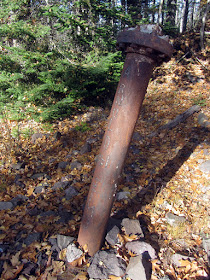These are the ruins of the engine house for the Arnold Mine's shaft #2, which I covered but briefly in an older post.
They have been cleaned up and made into a place of meditation by an order of Byzantine Catholic monks who live nearby--the same ones who operate "The Jampot" roadside stand. Their story is told in a recent Detroit Free Press article by John Carlisle.
As I said before, this mine was originally one of the holdings of its parent Copper Falls Mining Co., which was sold off by 1861. According to Mindat.org, the Arnold Mine explored the Ashbed Amydaloid Lode starting in 1860, and was incorporated in 1863. A "lode" is basically another term for a "vein" of metal ore embedded within a geological formation.
The Arnold Mine was worked sporadically until 1900, at which time all work ceased, though it had produced two million pounds of refined copper. As far as I know Arnold Schwarzenegger was never the governor of this mine, nor did he ever yell "GET BACK TO ZE COPPER" at the start of each shift.
It shut down and was stripped of its equipment after closing, allowing it to succumb to the ravages of nature. This included massive amounts of sediment being deposited from the nearby Jacob’s Creek, which gradually buried its stone ruins.
The Arnold Mine was then essentially lost to memory, and literally buried by the sands of time. Mike Forgrave of CopperCountryExplorer.com makes the interesting observation that over 70 years later the mine’s ruins made a sudden reappearance during the spring thaw of 1971 when a beaver dam burst, sending massive amounts of water downstream, not only washing out roads and at least one local business, but also uncovering the lost foundations of the Arnold. Roy L. Dodge’s Michigan Ghost Towns of the Upper Peninsula verifies this occurrence as well.
And now instead of my usual know-it-all blabbing, I will shut the hell up for once, and just let you enjoy the pretty pictures of old ruins in the Yoopee, as the monks intended.
After wandering for a ways, we found ourselves at a poor-rock pile, a place where waste spoils from a mine are stacked up in a mound. The monks had even arranged some of the boulders to form nice little pathways through the otherwise ugly rubble:
As it turned out we had wandered all the way to the Arnold Mine's shaft #1, whose cap marker was right here:
The pipe serves as a marker (and perhaps a vent) for the cap over the old mineshaft. The name and number of the mine is welded onto the side of the pipe for identification.
Further down the road and up the hill we wandered.
Suddenly, we realized we were so high up that we could see Lake Superior:
It was an absolutely perfect autumn day and we had nowhere to be, so we kept wandering. We decided to follow the creek that trickled past the Arnold Mine's poor rock pile.
Pretty soon we were finding little waterfalls, like every 50 yards or so. Maybe this wasn't just another average creek in the Yoopee, but I honestly had no idea which one it was, if it had a name.
We didn't know where this trail led exactly, or how far it went, but we were liking it so far.
We were going downhill pretty fast now, which of course meant more and more river drops, but I was sort of taken aback, since in order to come across this many waterfalls I usually have to do some actual, conscious itinerary planning.
Wow...the river actually formed a bit of a canyon here...
That's a helluva drop, for what I think is an unnamed falls.
(As I later figured out, this is named Upper Jacobs Falls, and we were following the Jacob's Creek, according to a great website by my colleague Jacob Emerick, Waterfalls Of The Keweenaw. And no, he did not name the falls after himself).
Also, according to Mr. Emerick's map, the first significant falls we had seen earlier was also called Arnold Mine Falls.
Up ahead through the trees we could start to see glimpses of deep blue Lake Superior, and the golden dome of what must be the monastery:
We still had a long way to go first before we got down to the bottom of this hill, and it got awfully steep near the end.
Finally, the last drop:
By the time we reached this point in our hike along the river, we had descended from around 1,200 feet above sea level to about 700 feet above sea level.
According to Waterfalls of the Keweenaw again, this was Jacob's Falls...and I suddenly had a total-recall moment where I realized that I had in fact actually seen this waterfall many times before, while driving along M-26, which we were currently standing on the shoulder of while taking this photo.
And here was the monastery, with its glimmering onion domes, towering over a cliff looking out on the vastness of Lake Superior:
We had reached The Jampot.
References:
http://www.mindat.org/loc-8488.html
Michigan Ghost Towns of the Upper Peninsula, by Roy L. Dodge
http://www.coppercountryexplorer.com/explorations/mines/arnold-mine/
http://www.freep.com/story/news/columnists/john-carlisle/2016/01/23/monks-making-jam-in-upper-peninsula-monastery/78371442/
































And you also had... one heck of a climb back up to your car.
ReplyDelete